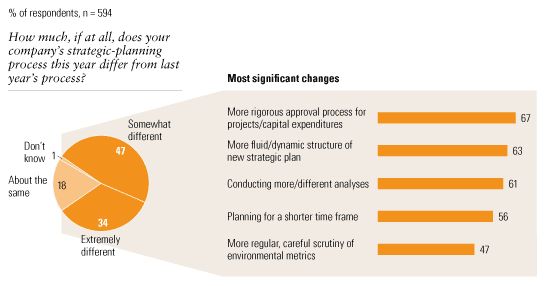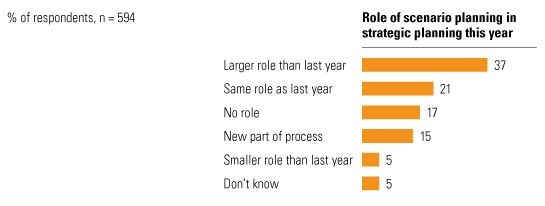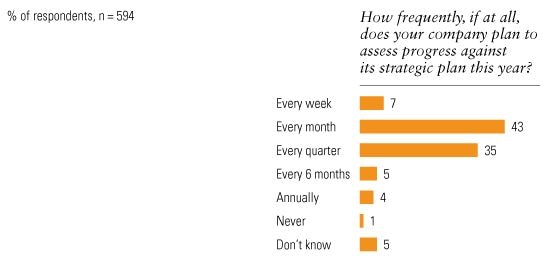Strategic-planning season has arrived for many companies, and it couldn’t be more different than it has been in years past. Gone are the days of linear trend-extrapolation exercises that produce base, upside, and downside cases. Strategists, now facing the most profoundly uncertain times in their careers, are creating disaster scenarios that would have been unthinkable until recently and making the preservation of cash integral to their strategies.
Most strategists we know are avoiding the obvious mistakes, such as planning as usual or, conversely, eliminating essential strategy-development activities or even strategic planning itself. Nonetheless, strategists remain deeply—and understandably—concerned that the priorities emerging from the annual planning rituals won’t address the demands of today’s tumultuous environment.
These are uncharted waters, and no one has a clear map for sailing through them. It’s clear that scenario planning, a well-established technique for coping with uncertainty, should play a critical role this year, but executing successfully has never been as challenging as it is now. Most companies will have to consider more variables and involve more decision makers than they have in the past. Strategists will also need to place a greater emphasis on measurement—the only way to recognize when changing conditions merit quick strategic adjustments. Finally, the focus on new or surprising scenarios shouldn’t obscure relevant long-term trends or devalue important existing strategies.
Be realistic about scenario planning
In a highly uncertain environment, the advantages of scenario planning are clear: since no one base case can be regarded as probable, it’s necessary to develop plans on the assumption that several different futures are possible and to focus attention on the underlying drivers of uncertainty.
Today’s pervasive uncertainty complicates scenario-planning efforts: the number of variables at play—and the range of plausible outcomes—have exploded in the past year. Consider, for example, the predicament of an industrial supplier that is not only heavily exposed to commercial and residential real estate but also has many government customers. For this company, the critical uncertainties include the direction of the commercial-credit and mortgage markets, housing prices, tax revenues, and government stimulus spending. Different outcomes for each of these uncertainties produce vastly different paths for the business. Since the heart of scenario planning—crafting a number of strategies for different outcomes—has become significantly more complex,1 strategists should prepare for a more demanding process of gathering information, exploring possibilities, and plain old hard thinking.
Senior executives outside the strategic-planning group—even those accustomed to developing scenarios—may find the diversity and complexity of this year’s scenarios bewildering. It’s critical to bring such executives into the process early: for example, by kicking off the planning process with a scenario-development exercise involving the full senior team. Similarly, as the process of reviewing business units gets under way, a company can inculcate an appreciation of the threats it faces and of its collective strategic response by inviting executives from a number of divisions to participate in the proceedings—rather than hold one-off events between the senior team and the leader of each individual unit.
Intensify monitoring
Depending on how events unfold, the industrial supplier mentioned above could make radically different moves. If the commercial and residential real-estate markets stabilized, it could expect reduced sales within those channels until the economy rebounded, but its business model would remain fundamentally the same. If those markets softened further, the bulk of the company’s market opportunity, for the foreseeable future, would lie in infrastructure investments underwritten by government stimulus spending. In that case, the company would need to redeploy its sales resources to government-oriented business and focus on maximizing sales there.
The company’s strategy, in short, must account for many more contingencies than it has until recently. Since the effectiveness of such a strategy depends on an organization’s ability to adjust rapidly as the fog starts to lift, managers must identify and intensively monitor key indicators suggesting which scenario might unfold. For the industrial supplier, some of the most important indicators are sales of new and existing homes, foreclosure rates, mortgage interest rates, new building starts, and announcements of “shovel ready” government projects. Of course, the company’s managers always followed such indicators, but the strategic-planning process typically collapsed their potential variations into average market growth forecasts. Given the present heightened uncertainty, however, the strategy group decomposed the average forecast into its individual elements to make the possible outcome for each of the indicators more transparent and to monitor them in greater detail.
There’s no occasion like the strategic-planning process to get a fix on such indicators—a fix that should also help companies make ongoing budget decisions in real time. That’s critical, because it makes no sense to set each operating unit’s budget allocation at the start of the fiscal year if cash is tight and corporate executives expect to dole it out carefully as plans become less uncertain. What companies need now is a dynamic “pay as you go” resource allocation process that conserves cash and encourages adherence to the strategic road map laid out in scenario planning.
This year’s planning process should also generate unusually specific plans to monitor the performance of suppliers, customers, and competitors. As we’ve seen in the past six months, the most entrenched incumbents can plunge into financial distress with dizzying speed. Early intelligence helps companies to recognize when they should negotiate more favorable supply terms, line up alternatives to risky suppliers, offer kinder credit terms to critical customers, accelerate collections from faltering ones, or scoop up all or part of vulnerable competitors. Leading indicators of distress include such familiar signals as delinquent accounts payable, downgraded debt ratings, large share price declines, late inventory deliveries, or lower-quality goods or materials. These signs, though all too familiar to operating managers, are typically addressed in an ad hoc way, not in the strategic-planning process. This year is different.
Look beyond the crisis
Given the vastness of the economic change now under way, the temptation for many planners will be to gaze, mesmerized, at the unfolding crisis. That’s a mistake, for at least two reasons.
First, devastating as the current downturn may be, it cannot roll back fundamental market trends—such as the aging of consumers in Europe and North America or the continued economic development of Brazil, China, India, and Russia—which will continue to create strategic opportunities and threats. Managers must focus their eyes—and resources—on these trends no matter what happens.
Second, planners who become fixated on current economic events run the risk of overlooking a core responsibility: evaluating the effectiveness of current strategies. Although the crisis may force companies to suspend or redirect some of them, others will remain relevant even in the changed environment. This year’s strategic-planning process is a time to encourage managers to sort out which current strategies the crisis has helped, hurt, or failed to affect and to ensure that a system and metrics are in place to track their performance. While all this may sound like common sense, extreme uncertainty makes it easy to overlook.
One company that’s staying the course is McDonald’s, which has profited in the downturn from its low-cost menu items and is enjoying its most robust same-store sales growth in years. Meanwhile, senior management has remained focused on longer-term strategies involving expensive store renovations, operational overhauls, high-end coffee products, and healthful menu options. Managers elsewhere can learn valuable lessons from the company’s efforts to benefit from the current circumstances while sticking to longer-term strategies and the underlying trends (such as healthier lifestyles) that they reflect.
Despite the challenging times, this year’s strategic-planning process need not be an exercise in anxiety or futility. Developing scenarios in greater depth, monitoring strategies more rigorously, and remaining focused on the long term will all help strategists boost the odds of creating plans that can lead their companies through the turbulence.
Strategic planning in a crisis: A McKinsey Quarterly Survey
Editor’s note. When we published this article in April 2009, we invited readers to take part in an online survey on changes in their companies’ strategic planning, given today’s challenging economic environment. Here is a summary of their responses.
Executives are concerned that a new focus on near-term challenges may cause this year’s planning process to overlook long-term trends or preexisting strategies, according to the results of a McKinsey Quarterly survey on strategic planning.2
More than 80 percent of executives say their strategic-planning processes look different this year compared with last (Exhibit 1). The change executives say has been most significant is the adoption of a more rigorous approach to approving projects and capital spending, presumably with an eye toward managing cash carefully. Other significant changes include the creation of strategies that are more dynamic, focus on the short term, and that include more analyses.
A different strategic-planning process

Scenario planning is becoming a leading part of the process. Over 50 percent of respondents say scenario planning either is playing a bigger role in their companies’ strategic planning this year or has been newly added to the process (Exhibit 2). And when asked to write in the element of their planning processes that has been most valuable in helping them cope with this year’s uncertain environment, more executives mention scenario planning than anything else. Nearly 60 percent of the respondents say their companies are monitoring progress against their strategic plans more frequently this year. Over 80 percent of respondents are assessing the progress of their strategic plans at least quarterly, with 50 percent doing so at least once a month (Exhibit 3).
Scenario planning in the spotlight

More frequent monitoring

In short, many strategists seem to be rapidly adjusting their planning processes to cope with the changed economic environment. Important as these adjustments may be, their nature also raise a major question in the minds of many strategists: is the crisis atmosphere undermining focus on all but the immediate future? More than 50 percent of executives, in fact, express worry about not striking the right balance between near-term challenges and long-term strategic priorities. The perennial challenge of striking this balance has become particularly acute this year.
